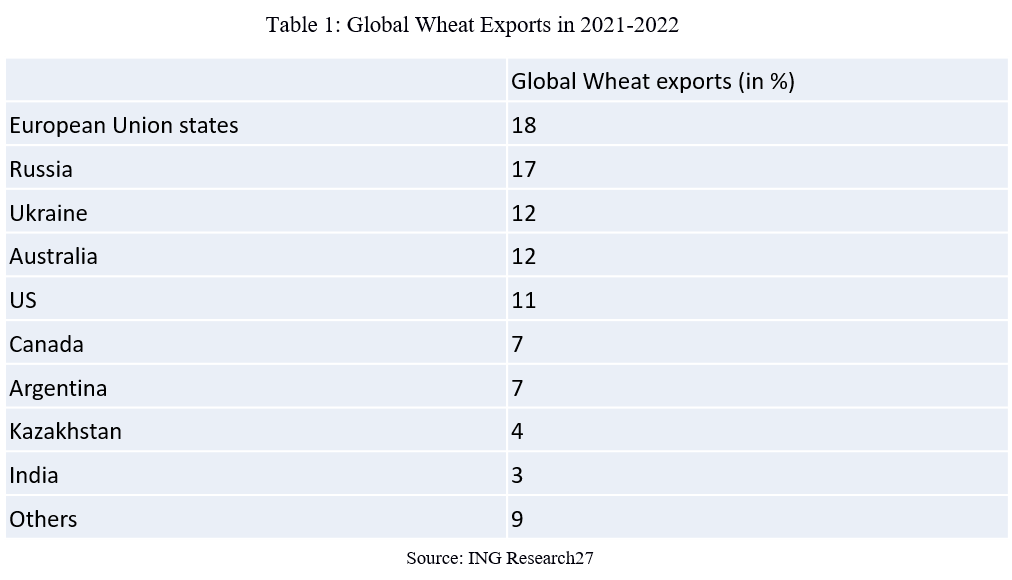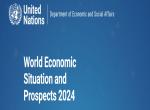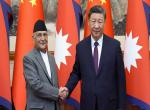On 24 February 2022, Russia launched military campaign against Ukraine after months of posturing, military build-ups and breakdown of the Minsk agreement that failed to resolve the conflict between the Ukrainian government and Russian-backed separatists in the two breakaway regions i.e. Donetsk and Luhansk. Russia’s policies in Ukraine are aimed at guaranteeing the right to self-determination in Russian dominated territories; demilitarisation; regime change; placing Ukraine in the Russian sphere of influence and thwarting North Atlantic Treaty Organisation (NATO)’s advances at any cost.
For West Asian and North African region, there are rising concerns about disruption in shipments of wheat causing shortages and price rise. Both Russia and Ukraine contribute to around 30 percent of global wheat production that are transported through the Black Sea ports. [1] Besides wheat, Russia and Ukraine provide 20 percent of global exports of corn and around 80 percent of sunflower seed products.[2] The Food and Agricultural Organisation (FAO)’s Cereal Price Index indicates a 17.1 percent surge in global prices of wheat and coarse grains triggered by the conflict. The loss of exports from the Black Sea region worsened the availability of wheat. The wheat prices in March were at its all-time high since 1990 that increased by 19.7 percent and price of coarse grain such as corn, barley, sorghum rose by 20.4 percent. [3]
Egypt’s Wheat Predicament
Egypt is the largest Arab state with population at 106.2 million [4] and around 29.7 percent people live under poverty [5] that depends on subsidised bread for sustenance. The Arab state was already facing high food inflation levels prior to the conflict. The current crisis poses challenge to Abdel Fatah Al Sisi government that has sought to overcome through borrowing from Gulf States, raising the interest rates and devaluing the currency. However, in case the conflict prolongs, Egypt could face social unrest and political instability in the near future.
Egypt is the largest importer of wheat receiving around 60 percent from Russia and 25 percent from Ukraine. [6] In 2021, Egypt imported more than 6.1 million tonnes of wheatat the total cost of US$ 2.4 billion. [7] Notably, Egypt imported 4.2 million tons of wheat at the cost of US$ 1.2 billion from Russia. In the same year, the wheat import from Ukraine was 651,400 tons at the cost of US$ 650 million. [8] Egypt’s total wheat consumption was at 21.3 million tonnes and it locally produced around 9 million tonnes in 2021-2022 [9] Egyptians consume between 150 and 180 kgs of bread per capita which is above the global per capita average of 70 to 80 kgs. [10] The subsidised bread is sold at 0.05 Egyptian pound or US$ 0.0032 per loaf to more than 60 million Egyptians. [11]
The availability of cheap bread is a sensitive issue in the Arab world especially in Egypt. The government structure under Abdel Gamal Nasser relied on social contract between the state and the citizens in which political loyalty was obtained by providing subsidised goods and services including cheap bread. The cut off in subsidies on bread on several occasions have led to street protests and violence, notably the 1977 bread riots. The high annual food inflation at 18.9 percent[12] including rise in price of bread called ‘aish’ meaning life in Egyptian Arabic contributed in the anti-government protest in 2011 in which chant such as “bread, freedom and social justice” were commonly heard[13] President Abdel Fatah Al Sisi came to power in 2013 after ousting the Mohammad Morsi led Muslim Brotherhood government. Sisi pushed for neo-liberal measures including subsidy cuts and devaluing the currency in 2016 leading to high level of inflation. In March 2017, protests broke out in several major cities in Egypt after the government lowered the state-sponsored provision of bread from 4000 to 500 loaves per bakery. The government fearing large scale social unrest was forced to rescind the said measures. [14] Sisi on 3 August 2021 again hinted about the possibility to change the subsidy system on bread without specifying the amount. [15] The government however did not increase the price which may change if the conflict between Russia and Ukraine continues.
Impact of Russia-Ukraine Conflict
Egypt’s food system is highly fragile due to the agricultural sector’s inability to produce cereal grains especially wheat and oilseeds to cater to the vast population. Egypt is highly dependent on imports to provide sufficient and affordable bread and vegetable oil. Egypt has contested the construction of the Grand Ethiopian Renaissance Dam (GERD) by Ethiopia. Egypt’s annual water reserves and agricultural area, after the completion of the GERD project, would be dependent on the duration of time taken by Ethiopia to fill the reservoir. Therefore, in case of shorter timeframe in filling the reservoir, the water flow in Egypt would significantly reduce decreasing the total agricultural area. Egypt’s conflict with Ethiopia could further escalate in view of its growing import dependence for meeting the requirements of wheat.
In Egypt, one week after the Russian military invasion on 24 February, the price of one ton of wheat increased in the local market from Egyptian Pound 9,000 or US$ 487 to Egyptian Pound 11,000 or US$ 595. [16] The government spends around US$ 3 billion per year on wheat imports. Due to the conflict however, the wheat prices could raise to US$ 5.7 billion. [17] The rise in wheat prices has led to 25 percent increase in price of popular kinds of bread other than the subsidised variety provided by the government. According to the government, 80 percent of Egyptians receiving up to five loaves per day for every family member on ration cards.[18]
The government anticipating the disruption in February assured that the state has nine months’ worth of wheat including five months of strategic reserves and four months from domestic production. It also introduced export bans of wheat, fava beans, lentils and pasta and provided new regulations and incentives for Egyptian farmers to increase local supply.[19] Cairo took measures to cope with the economic repercussions and the food crisis. On 21 March 2022, the government’s decision to devalue its currency led to14 percent loss in its value causing hike in prices. Notably, the value of US$1 soared from 15.65 to 18.20 Egyptian Pound.[20] It is expected that devaluation of the currency and rate hike would help to protect the foreign exchange reserve buffer in light of capital outflows and higher food and energy import cost. Moreover, relief package worth US$ 7.1 billion has been established that includes hike in salaries, limiting effect of price rise on poor population through cash transfers.[21]
On 22 March, the government announced a fixed price for bread sold outside the subsidy system to avert the risk of price rise that may cause social unrest. Reportedly, security agencies have advised the top leadership against considering increase in bread prices at this juncture that could lead to social and political instability. The Egyptian Ministry of Supply identified 14 states including Australia, the US, Canada, Paraguay and India to receive wheat supply. However, price rate for purchase is likely to increase in terms of transportation during the current high fuel prices straining the economy.
The Gulf States are aware about the implication of the economic downturn and food shortage in the largest Arab state that could lead to a new wave of anti-government protests possibly destabilising the region. The United Arab Emirates (UAE) on 23 March announced investment worth US$ 2 billion in Egypt. Abu Dhabi based investment fund ADQ has offered the sum and committed to purchase stakes in local banks, industrial firms such as Commercial International Bank; Misr Fertilizers Production Company and Alexandria Container & Cargo Handling Company.[22] Saudi Arabia also deposited US$ 5 billion and pledged to invest total sum of US$ 15 billion in Egypt. Qatari Foreign Minister Mohammed bin Abdulrahman Al Thani visited Cairo on 29 March 2022 and announced plan to provide US$ 5 billion to strengthen economic and investment cooperation.[23]
The integration of Arab region with global markets has caused slowdown in local food production. Egypt consequently depended on food imports reducing self-sufficiency and utilised the arable land to produce cash crops that are convenient for exports. The adoption of liberalisation policies and cuts in public spending in 1980s also led to decline in local productivity. Under IMF and World’s Bank’s structural adjustment programmes, agricultural subsidies were gradually removed and priority was given to export-oriented production. According to Arab Group for the Protection of Nature (APN), the main challenge for the region is loss of sovereignty over land, food and resources due to interference by external actors and global financial institutions. According to APN, only about 30 percent of the estimated 200 million hectares of arable land is cultivated in the region.[24] The region is affected by extreme temperature and water stress impacting the ability to ascertain food security.The crisis has forced Egypt to prioritise local production of essential food supplies for social, economic and political security.
For Egypt, there is need for serious effort to diversify its food import sources; upgrade water and land management; increase domestic agricultural production by 38 percent; invest in local food systems and regional strategy for food security. In terms of long-term solution, the farming system should address imminent water shortages; threats from climate variability and boost resilience that leads to sustainable increase in production. It should increase agricultural output by modernising the farming sector through use of advanced agri-tech, water management and green energy technology. Egypt could collaborate with the US and Israel through joint venture investment partnership to raise local food production and promote regional agricultural cooperation in the eastern Mediterranean region. Moreover, deliberate effort to reduce food waste; tackling malnutrition by shifting dependence on wheat to incorporate more diverse set of grains and reforming the food subsidy system to reduce inefficiencies in wheat sector could contribute in increasing productivity[25].
India as an Option
The Russia-Ukraine conflict and resulting impact on food security in Egypt as well as the region has offered a unique opportunity for India to penetrate the West Asian and North African markets. The Egyptian government since March 2022 has been deliberating with India to import wheat. Indian Minister of Commerce and Industry, Piyush Goyal met with Egyptian Minister of Planning & Economic Development, Dr. Hala El-Said and discussed about the possibility of importing high quality wheat and ensuring Egypt’s food security. Egyptian officials from agriculture quarantine and pest risk analysis have visited several processing units, port facilities and farms in Punjab, Madhya Pradesh and Maharashtra to assess the viability of wheat imports from India. Goyal has assured to provide the best quality of wheat and ensure that India is seen as a sustainable wheat supplier for Egypt.[26]

India was relatively a marginal actor in the global wheat trade exporting 0.2 million tonnes in 2019-2020. India until 2021 was not under the list of accredited states that could export wheat to Egypt. It has substantially increased wheat exports in the past two years increasing the total volume at 2.15 million tonnes in 2020-2021. The recent events could help India to establish itself as major wheat producer. Indian wheat is exported to the UAE, Qatar, Oman, Bangladesh, Sri Lanka and Malaysia. Reportedly, besides Egypt, Israel, Oman, Iran, Sudan, South Africa, Nigeria, Bosnia and China have reached out to India to purchase wheat. Indian Commerce & Industry Ministry has established a task force that includes representatives from commerce, shipping, railways ministries under the aegis of the Agricultural and Processed Food Products Export Development Authority (APEDA) to promote wheat exports. APEDA has planned to send trade delegations to Morocco, Tunisia, Algeria, Turkey, Lebanon, Turkey, Vietnam, Thailand, Philippines to explore the possibility of wheat exports. [28] India exported 8.7 million tonnes of wheat in 2021-22 and planned to export 10 million tonnes of wheat in 2022-2023 which according to some analysts could increase to 15 million tonnes.[29] India has already sent 55,000 tonnes of wheat in April to Egypt. In late April 2022, around 180,000 tonnes of wheat was planned for shipping to Israel and Mozambique.[30]
The record breaking heat wave in India could affect the wheat output in 2022-2023. It could raise difficulty in balancing between the domestic needs and plans to increase wheat exports to states seeking for alternate sources hit by Russia-Ukraine conflict. The quality of the wheat is crucial to ensure that it is suitable for making bread, noodles and animal feed. The Indian government has to ensure that impurities such as dust, sand, stones in the grain are removed. Moreover, Karnal burnt disease that can reduce the flour quality and overuse of pesticides must be tackled to ensure that it is suitable for exports.[31]
References :
[1] FAO, “Impact of the Ukraine-Russia conflict on global food security and related matters under the mandate of the Food and Agriculture Organization of the United Nations (FAO)”, Food & Agriculture Organization, April 8, 2022, at https://www.fao.org/3/ni734en/ni734en.pdf (Accessed April 28, 2022).
[2] N. Turak, “Russia’s war is threatening the Middle East’s food security - sparking warnings of riots, famine, and mass migration”, CNBC, April 28, 2022, at https://www.cnbc.com/2022/04/28/russia-ukraine-war-threatens-the-middle-easts-food-security.html (Accessed April 29, 2022).
[3] FAO, “FAO Food Price Index posts significant leap in March”, Food & Agriculture Organization, April 8, 2022, at https://www.fao.org/newsroom/detail/fao-food-price-index-posts-significant-leap-in-march/en (Accessed April 29, 2022)
[4] United Nations Population Fund, “World Population Dashboard: Egypt”, United Nations Population Fund, 2022, at https://www.unfpa.org/data/world-population/EG (Accessed April 29, 2022).
[5] Egypt Today, “Poverty rates in Egypt decline to 29.7% within year”, Egypt Today, October 18, 2021, at https://www.egypttoday.com/Article/3/108951/Poverty-rates-in-Egypt-decline-to-29-7-within-year (Accessed April 30, 2022).
[6] Business Standard, “Middle East to suffer from the grain shortage due to the war in Ukraine”, Business Standard, March 7, 2022, at https://www.business-standard.com/article/international/middle-east-to-suffer-from-the-grain-shortage-due-to-the-war-in-ukraine-122030700098_1.html (Accessed April 29, 2022).
[7] Zawya, “Egypt’s wheat imports hit $2.4bln in 11 months”, Zawya, February 28, 2022, at https://www.zawya.com/en/markets/commodities/egypts-wheat-imports-hit-24bln-in-11-months-klt7w2oj (Accessed April 30, 2022).
[8] K. Dawoud, “The Russia-Ukraine war might finally bring about a rise in Egypt’s bread prices”, Middle East Institute, March 28, 2022, at https://www.mei.edu/publications/russia-ukraine-war-might-finally-bring-about-rise-egypts-bread-prices (Accessed April 30, 2022).
[9] USDA, “Egypt is able to secure a steady supply of grains during the COVID-19 pandemic”, United States Department of Agriculture, March 17, 2021, at https://apps.fas.usda.gov/newgainapi/api/Report/DownloadReportByFileName?fileName=Grain+and+Feed+Annual_Cairo_Egypt_03-15-2021.pdf (Accessed April 29, 2022).
[10] H. Hendawi, “Why ending Egypt’s bread subsidies holds great significance”, The National, August 13, 2021, at https://www.thenationalnews.com/mena/2021/08/13/why-ending-bread-subsidies-feels-like-an-existential-threat-to-egyptians/ (Accessed April 29, 2022).
[11] Al-Arabiya News, “Egypt’s Sisi price of subsidized bread needs to be raised”, Al Arabiya, August 3, 2021, at https://english.alarabiya.net/business/economy/2021/08/03/Egypt-s-Sisi-price-of-subsidized-bread-needs-to-be-raised (Accessed April 28, 2022).
[12] R. Zurayk, “Use your loaf: why food prices were crucial in the Arab spring”, The Guardian, July 17, 2011, at https://www.theguardian.com/lifeandstyle/2011/jul/17/bread-food-arab-spring (Accessed April 27, 2022).
[13] France 24, “Egypt’s revolution, 10 years on: What happened to ‘bread, freedom & social justice”, France 24, January 25, 2021, at https://www.france24.com/en/tv-shows/the-debate/20210125-egypt-s-revolution-10-years-on-what-happened-to-bread-freedom-social-justice (Accessed April 29, 2022).
[14] R. Michaelson, “We want bread: subsidy cut sparks protests across Egypt”, The Guardian, March 8, 2017, at https://www.theguardian.com/world/2017/mar/08/egypt-protests-we-want-bread-subsidy-cut (Accessed April 30, 2022).
[15] H. Hendawi, “Egypt’s El Sisi makes case for raising price of bread”, The National, August 14, 2021, at https://www.thenationalnews.com/mena/2021/08/14/egypts-el-sisi-makes-case-for-raising-price-of-bread/ (Accessed April 28, 2022).
[16] K.Dawoud, “Russia-Ukraine war and Egypt’s bread prices”, Jordan News, April 6, 2022, at https://www.jordannews.jo/Section-36/Opinion/Russia-Ukraine-war-and-Egypt-s-bread-prices-15263 (Accessed April 29, 2022).
[17] News 18, “Egyptians Count Rising Bread Costs as Ukraine War Disrupts Wheat Exports”, News 18, March 17, 2022, at https://www.news18.com/news/world/egyptians-count-rising-bread-costs-as-ukraine-war-disrupts-wheat-exports-4883726.html (Accessed April 30, 2022).
[18] Al Jazeera, “Egypt pound drops as Ukraine war prompts dollar flight”, Al Jazeera, March 21, 2022, at https://www.aljazeera.com/news/2022/3/21/egyptian-pound-drops-after-ukraine-war-prompts-dollar-flight (Accessed April 29, 2022).
[19] Ahram Online, “Egypt bans export of wheat, other staples for 3 months”, Ahram Online, March 10, 2022, at https://english.ahram.org.eg/News/462620.aspx (Accessed April 30, 2022).
[20] P. Werr& N. Awadalla, “Egypt devalues currency 14% after Ukraine war prompts dollar flight”, Reuters, March 21, 2022, at https://www.reuters.com/world/africa/egyptian-pound-drops-10-after-ukraine-war-prompts-dollar-flight-2022-03-21/ (Accessed April 29, 2022).
[21] D. Dudley, “Rich Gulf States Line Up to Offer Egypt Billions of Dollars”, Forbes, March 30, 2022, at https://www.forbes.com/sites/dominicdudley/2022/03/30/rich-gulf-states-line-up-to-offer-egypt-billions-of-dollars/?sh=6b99db4a7da3 (Accessed April 28, 2022).
[22] M. Magdy, “Abu Dhabi to Deepen Egypt Ties With Deals Worth $2 Billion”, Bloomberg Quint, March 21, 2022, at https://www.bqprime.com/business/abu-dhabi-said-to-deepen-egypt-ties-with-deals-worth-2-billion (Accessed April 30, 2022).
[23] M. Magdy& A. L. Wahba, “Saudi Arabia Joins Egypt’s Gulf-Cash Influx With $15 Billion”, Bloomberg Quint, March 30, 2022, at https://www.bqprime.com/politics/saudi-arabia-makes-5-billion-deposit-in-egypt-central-bank (Accessed April 28, 2022).
[24] M. Vidal, “Russia-Ukraine war: Calls for Middle East food sovereignty amid looming wheat crisis”, Middle East Eye, March 19, 2022, at https://www.middleeasteye.net/news/russia-ukraine-war-middle-east-food-sovereignty-looming-wheat-crisis (Accessed April 29, 2022).
[25] K. Abay; L. Abdelfattah; C. Breisinger; J. Glauber& D. Laborde, “The Russia-Ukraine crisis poses a serious food security threat for Egypt”, International Food Policy Research Institute, March 14, 2022, at https://www.ifpri.org/blog/russia-ukraine-crisis-poses-serious-food-security-threat-egypt (Accessed April 28, 2022).
[26] The Hindu, “Egypt approves India as wheat supplier: Goyal”, The Hindu, April 15, 2022, at https://www.thehindu.com/news/national/egypt-approves-india-as-wheat-supplier-goyal/article65323264.ece (Accessed April 30, 2022).
[27] ING, “Russia-Ukraine conflict: What it means for grain and oilseed markets”, ING, March 7, 2022, at https://think.ing.com/articles/russia-ukraine-conflict-what-it-means-for-grain-markets (Accessed April 29, 2022).
[28] Press Information Bureau, “Press Release”, Press Information Bureau, April 15, 2022, at https://pib.gov.in/PressReleaseIframePage.aspx?PRID=1817118 (Accessed April 29, 2022).
[29] S. Das, “India aims to export 10 million tonne of wheat worth $4 billion in 2022-23”, Financial Express, April 4, 2022, at https://www.financialexpress.com/economy/india-aims-to-export-10-million-tonne-of-wheat-worth-4-billion-in-2022-23/2480352/ (Accessed April 28, 2022).
[30] B. Muftuoglu, “India to send first wheat cargo to Egypt”, Argus Media, April 25, 2022, at https://www.argusmedia.com/en/news/2325114-india-to-send-first-wheat-cargo-to-egypt (Accessed April 29, 2022).
[31] Live Mint, “Quality matters in India’s drive to fill global wheat export gap”, Live Mint, April 19, 2022, at https://www.livemint.com/economy/quality-matters-in-india-s-drive-to-fill-global-wheat-export-gap-11650357330185.html (Accessed April 29, 2022).
(The paper is the author’s individual scholastic articulation. The author certifies that the article/paper is original in content, unpublished and it has not been submitted for publication/web upload elsewhere, and that the facts and figures quoted are duly referenced, as needed, and are believed to be correct). (The paper does not necessarily represent the organisational stance... More >>
Image Source: https://www.fao.org/fileadmin/user_upload/country-showcase/images/large_1_FAO_Ancient-Egyptian-Agriculture.jpg




_1_0.png)






Post new comment